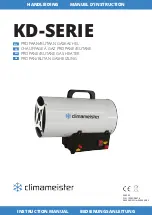
10
Rittal air/water heat exchanger assembly instructions
4 Assembly and connection
EN
4.4 Connecting the condensate discharge
A flexible condensate discharge hose (Ø
1
/
2
˝) can be
fitted to the air/water heat exchanger.
The condensate discharge
– must be laid with a suitable and constant gradient
(no siphoning)
– must be laid without kinks
– must not have a reduced cross-section if extend-
ed.
The condensate hose is available as an accessory
(refer also to Accessories in the Rittal Catalogue).
Fig. 8:
Connect the condensate discharge to the side
of the unit
• Connect a suitable hose from the right or rear to the
condensate nozzle screwed into the unit, and
secure it with a hose clip (with 2 Nm torque).
• Lay the condensate hose, e.g. into a drain.
Fig. 9:
Lay the condensate discharge to the side of the unit
4.5 Connecting the water connection
A compression-proof flexible condensate discharge
hose (Ø
1
/
2
˝) for both the supply and the return can
be fitted to the air/water heat exchanger.
The cooling water hose
– must be laid without kinks
– must not have a reduced cross-section if extended
and, if necessary, must be insulated.
Fig. 10:
Connect the cooling water inlet (top) and
return (centre) to the side of the unit
• Reseal the connection nozzles using teflon tape or
hemp and sealing paste.
• Connect a suitable hose to each of the two cooling
water connection nozzles (at the side or rear of the
unit) and secure each one with a hose clip (with
15 Nm torque).
The unused cooling water connecting pieces must
be closed appropriately with sealing bungs (with
15 Nm torque).
Note:
The water circuit should be protected from
ingress of dirt or excess pressure (maxi-
mum permitted operating pressure 10 bar)!
Note:
Observe the flow direction and check
for leaks!
Summary of Contents for SK 3209. Series
Page 2: ......











































